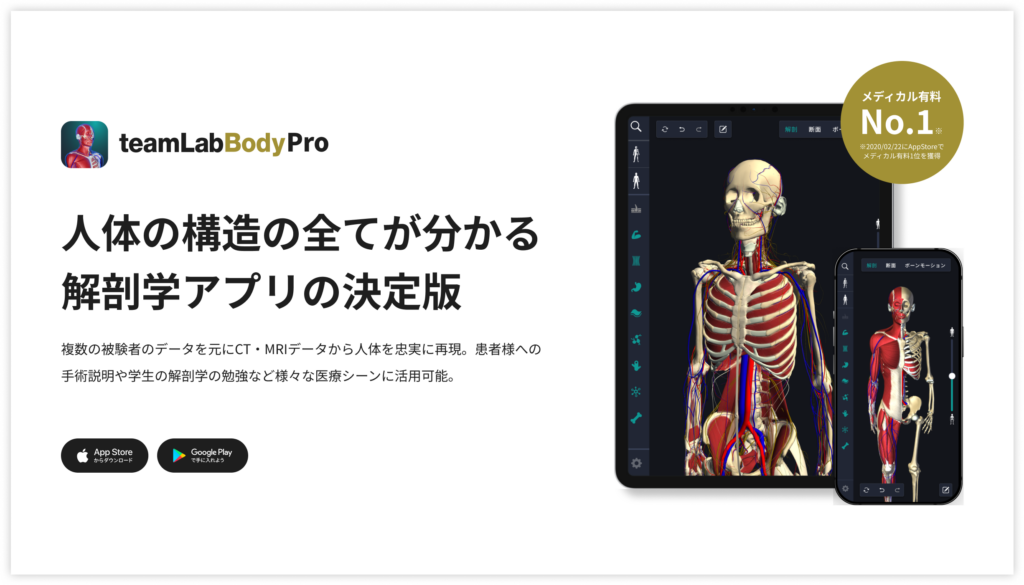beginning
In this article, I will explain the “calcaneofibular ligament” in detail.
The calcaneofibular ligament stabilizes ankle movement and plays a role in protecting the ankle from inappropriate movements such as sprains, etc., and care during sports activities is particularly important. Similarly, the anterior talofibular ligament also contributes to ankle stability, preventing the foot from twisting inward, etc., and both ligaments support ankle safety and comfortable walking. These ligaments have important functions from daily life to exercise, and it is important to maintain ankle health through proper care and prevention measures. Please use this article to deepen your understanding of the body.
Click here to watch a video about calcaneofibular ligament (calcaneofibular ligament)
teamLab Body Pro Free Download
A 3D anatomy app that shows all the structures of the human body
Download teamLab Body Pro here!

What is the calcaneofibular ligament
The calcaneofibular ligament is one of the important parts of the ankle and plays a role in maintaining the stability of the ankle. It protects the ankle from improper movement and is important in a wide range of activities, from everyday activities to sports.
How to read calcaneofibular ligament
The calcaneofibular ligament is read as “stiff.”
Characteristics of calcaneofibular ligament
The calcaneofibular ligament has the role of stabilizing the movement of the ankle, and it is an area that is prone to sprains such as twisting the foot outward. Therefore, it is especially important for people who play sports to take care of the calcaneofibular ligament.
Location and position of calcaneofibular ligament

The calcaneofibular ligament is a ligament that starts at the lower end of the fibula bone (outer ankle) and extends to the heel bone (heel bone). Please check the exact position on the human anatomy chart.
How to remember calcaneofibular ligament
Remember the ankle's “key band that connects the fibula that protects the outside and the calcaneus.”
English and Latin for calcaneofibular ligament
The calcaneofibular ligament is expressed as “Calcaneofibular Ligament” in English, and is called “Ligamentum Calcaneofibulare” in Latin.
Trivia about calcaneofibular ligament
Here's some trivia.
The calcaneofibular ligament is known as an area prone to sprains, and care must be taken especially during sports. Since ankles affect movement in daily life, it's important to be aware not to damage them.
Tissues associated with calcaneofibular ligament: characteristics of anterior talofibular ligament
The anterior talofibular ligament is a part that is often overlooked, but it is an important ligament that stabilizes ankle movement. This ligament plays a role in preventing the foot from twisting inward and supporting the ankle so that it does not wobble even when running or jumping. Furthermore, the anterior talofibular ligament works together with the calcaneofibular ligament to help you walk comfortably in accordance with complex foot movements. Whereas the calcaneofibular ligament supports the entire ankle and foot over a wide area, the anterior talofibular ligament functions during foot rotation.
Tissues related to calcaneofibular ligament: location and position of anterior talofibular ligament
The anterior talofibular ligament is located at the front of the ankle, starts at the lower end of the tibia (shin bone), and attaches to the front of the fibula (bone located outside the shin bone). It restricts forward bending and pronation (internal twisting movements) and protects the joint from excessive movement.
Tissues associated with calcaneofibular ligament: trivia about anterior talofibular ligament
Here's some trivia.
• Damage-prone ligaments: The anterior talofibular ligament is one of the areas where athletes are particularly prone to sprains and injuries. When unexpected pressure is applied to the ankle due to improper landing, it may cause hyperextension or rupture.
• Treatment and rehabilitation: An anterior talofibular ligament injury can be recovered with proper treatment. Severe cases may require surgery, but are often treated through physical therapy, proper stretching, and strengthening exercises.
• Prevention is key: Strengthening the muscles around the ankle is an effective way to prevent damage. Also, be aware of how to properly use your feet in your daily life, and in particular, it is important to warm up sufficiently before exercise and cool down after exercise.
The anterior talofibular ligament and calcaneofibular ligament complement each other while maintaining ankle stability. Be aware of the health of these ligaments from your daily life to when exercising.
summary
This time, I explained the location and location of the “calcaneofibular ligament,” how to memorize it, and the English and Latin notation.
How was it?
I would be happy if reading this article deepened my understanding of anatomy.
Learning is a long, never-ending journey, but I sincerely wish you all the best. Let's continue to study together and work hard for the national exam!
Please look forward to the next blog.
Learn more with the anatomy app “TeamLabBody Pro”!
teamLabBody Pro is a “3D human anatomy application” that covers the entire body of the human body, including muscles, organs, nerves, bones and joints.
The human body is faithfully reproduced from CT and MRI data based on data from multiple subjects. Since medical book-level content supervised by physicians can be freely viewed from all angles, it can be used for various medical situations, such as explaining surgery to patients and studying anatomy for students.
If you want to see the parts introduced this time in more detail, please download the anatomy application “teamLabBody Pro.”
■teamLab Body Pro Free Download





